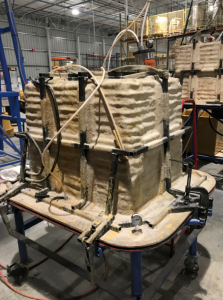By Ed Kammerer, OPW
So, you’ve completed your research, performed your due diligence and selected what you think is the best dispensing and underground storage tank equipment and systems for your new fueling site, or an upgrade to an existing one. Installation
While your equipment and systems were, as required, up to code when they were installed, the regulatory agencies are always working on ways to tweak, revise and improve their regulations. This puts pressure on fuel-site operators to stay abreast of any impending regulatory changes and to be aware of how they may affect the regularity status of their operations, and what they must do to remain compliant if any changes are required.
For example, Underwriters’ Laboratories (UL) recently implemented changes to its regulation regarding “Containment Sumps, Fittings and Accessories for Fuels.” Called the UL-2447 standard, this regulation updates the requirements for sumps, fittings and their accessories regarding “design and technology, regulatory compliance, industry needs” and addresses “scope of use, biofuels, compatibility and functional safety issues with respect to generally expected assembly, use and environmental conditions over the product’s average service life.”
Specifically, UL-2447 lays out a Test Program for fiber-reinforced polymer (FRP), or fiberglass, sumps. These types of sumps are a relatively recent arrival on the scene, created by fuel-site equipment manufacturers who determined that FRP performs better than the more traditional polyethylene (PE) in sump construction. This has led to fiberglass sumps being specified more frequently at retail and commercial fueling sites. In conjunction with this, UL-2447 specifically targets FRP sumps with a series of tests that must be performed by the manufacturer to ensure their viability. These tests include:
- Leak Prevention. The FRP sump’s retention valves must be able to retain 70% of Type A and B fuels, as opposed to the old standard demanding retention of 50% of Type A and 30% of Type B fuels.
- Fluid Compatibility. Samples of the sump are immersed in Type A and Type B external fluids periods of 30, 90, 180 and 270 days, and Type A and B internal fluids for a period of 30 days. After these testing periods, the samples must test within a range of flexural strength (50% for Type A fluids and 30% for Type B fluids) as compared to the flexural sump in as-received condition.
- Air-Oven Aging. Samples of the sump are placed in an air-circulating oven at a temperature of 158ºF (70ºC) for periods of 30, 90 and 180 days. At the completion of these time periods, the sample must have a flexural strength of at least 80% of the flexural strength of the sump in as-received condition.
- Cold-Impact. Samples from the bottom and side of the sump are placed in a freezer with a temperature of -20ºF (-29ºC) for 16 hours. When removed from the freezer, the sample are subjected to an impact from a 1.18-pound steel ball dropped from a height of six feet. Upon impact, the samples must not crack.
- Hydrostatic Load. Sumps with penetration fittings installed are filled to capacity with water for 24 hours. At the completion of that time frame, there can be no leakage.
- Samples of the sump material are subjected to infrared analysis, differential scanning calorimetry analysis, thermogravimetric analysis, percent ash content and specific-gravity determination, with the results kept on file by UL and used as a baseline for followup Identification tests.
Realizing the importance of developing FRP sumps that can meet the UL-2447 standard, manufacturers have taken great pains to create products that satisfy UL-2447, with the most critical consideration being the method with which they are manufactured.
A Reliable Alternative
As mentioned, FRP tank sumps have become a popular choice for fuel retailers because they offer some significant benefits over PE sumps. The most basic benefit is that fiberglass is compatible with most fuel formulations and additives, including alternative fuels made with ethanol (E15, E85, etc.) and biodiesel (B20, B100, etc.). Additional advantages of FRP sumps are higher corrosion resistance; higher structural strength, which allows them to withstand underground loading, ground movement and hydrostatic pressure; watertight construction when properly molded and installed; ability to be molded into many unique shapes and sizes; can be easily bonded together; can be repaired quickly in the field; and can last for 30 years or more. All of these benefits come into play when the FRP sump is subjected to the tests of the UL-2447 Test program.
While the evolution of FRP sumps has been an improvement for fuel retailers, site operators still must be aware that all fiberglass sump manufacturing methods are not created equal – meaning some may be used that will produce sumps that will have difficulty satisfying the UL-2447 tests.
There are four common FRP-manufacturing methods and two main materials (polyester resin and glass) that are used to produce fiberglass sumps. They are:
- Hand Layup: Also known as “wet” layup, with this method the resin and glass are essentially hand-painted onto a single-sided mold with a roller before a thin layer of gel coat is applied to seal any holes in the fiberglass.
- Chopper Gun Layup: This method is similar to hand lay-up, except that a spray gun is used to apply the mixture of resin and glass to a single-sided mold and then gel coat is typically applied to the finished product.
- Filament Wound: A mold is placed on a steel mandrel that slowly rotates as a fine string of glass/resin filament is sprayed on the mold to create the sump.
- Vacuum-Assisted Resin Transfer Molding (RTM): This is a carefully controlled manufacturing process in which a male and female sump mold are mated together sandwiching a glass mat and a vacuum is used to form an airtight seal between the two molds as the resin is pulled by vacuum into the space between the two molds. This provides a controlled and consistent ratio of resin and glass as well as consistent wall thicknesses in each sump that comes out of the mold.
As expected, the hand/wet layup and chopper gun layup construction methods are the least expensive, but – in line with the “you get what you pay for” mantra – they are of the lowest quality. Specifically, cheap molds (also known as tools) are used to construct the sump. These molds wear out quickly and can result in part deformity or inconsistency during the construction process. Also, each molded part is reliant on the molder repeating the resin and glass application process exactly. The molder must also be sure that the fiberglass is completely “wetted” out, but in order to ensure this, the molder may paint too much resin on the mold, resulting in inconsistent wall thicknesses. This can also lead to brittles areas where the sump wall is resin rich (too much resin and not enough glass). It can also lead to areas of the sump wall with not enough resin and too much glass causing that section to wick or leak any water or fuel that comes in contact with that area.
Another drawback is that the molded part will be rough on one side, making it difficult to work with in the field. The rough surfaces make it challenging for entry fittings to properly seal causing a potential leak point. The parts may also have to be gel-coated to achieve the required level of watertightness, with the gel-coat layer often applied inconsistently and prone to being scratched off or damaged during transport or installation. Finally, these “open” molding processes release polyester resins, paint vapors and solvents into the air, which may cause air-quality issues and expose molders to hazardous vapors that are above approved regulatory levels.
The Case For RTM Sumps
Conversely, the vacuum-assisted RTM manufacturing process eliminates the concerns associated with the hand/wet and chopper gun layup processes while delivering a long list of benefits:
- The tooling is made of high-end metal or epoxy-based composites with metal inserts to ensure consistency and shape
- Each sump is molded according to a precise, predetermined and controlled process that is done under vacuum, resulting in consistent wall thicknesses and high-quality construction
- The vacuum source completely pulls the polyester resin through the fiberglass, a capability that guarantees a fully wetted out, solidly built and with lower permeability
- The use of male and female molds ensures that both sides of the sump will have a smooth and visually appealing finish
- No gel coat is needed to achieve watertightness
- The “closed” molding process releases no polyester resins, paint vapors or solvents into the air, meaning that air quality is not affected and falls within regulatory standards
The ultimate benefit of RTM-manufactured FRP sumps is that they are capable of more reliably containing any fuel that may leak or spill during dispenser operation, as the result of a submersible-pump leak within the tank sump or during underground storage tank (UST) refills. Failure to contain any leaking fuel can lead to contamination of the soil and surrounding groundwater supply. If undiscovered or left unchecked, any uncontained leaks or spills will put the site out of compliance, which can result in heavy fines, along with cleanup and restitution costs, with the worst-case possibility that the site may be shut down permanently.
With the number of regulatory standards that must be satisfied – many of which are constantly being revised – it’s not uncommon for fuel-site operators to get the feeling that Big Brother is always watching. Though these regulations can be thought to be restrictive or overzealous, in reality, the regulatory agencies only have the best interests of the retailer, environment and general public in mind, especially when it comes to the handling, dispensing and storing of motor fuels.
The ongoing conversion from PE to FRP sumps has unquestionably aided the fuel-site operator’s peace of mind when it comes to fuel containment and public and environmental safety. However, those benefits can be lost when substandard FRP sumps are used. An FRP sump manufactured using the hand/wet layup or chopper spray gun process may have half the cost of an RTM sump, but it also will likely have one-third the quality. So, before you are ready to start dispensing fuel at that new or upgraded fuel site, make sure your FRP sumps are UL-2447 listed, which will give them the capability to reliably perform for many years.
 Ed Kammerer is the Director of Global Product Management for OPW, based in Cincinnati, OH, USA. He can be reached at [email protected]. OPW delivers a comprehensive line of fueling equipment and services to retail and commercial fueling operations around the globe. For more information on OPW, please go to opwglobal.com.
Ed Kammerer is the Director of Global Product Management for OPW, based in Cincinnati, OH, USA. He can be reached at [email protected]. OPW delivers a comprehensive line of fueling equipment and services to retail and commercial fueling operations around the globe. For more information on OPW, please go to opwglobal.com.










